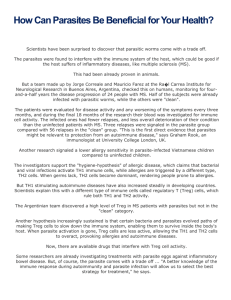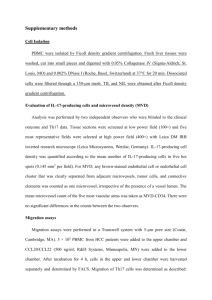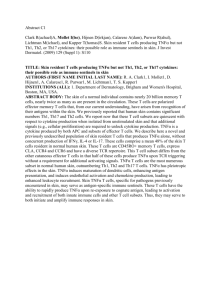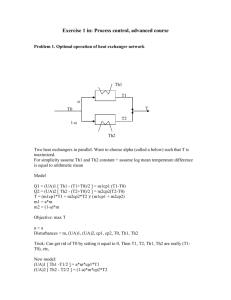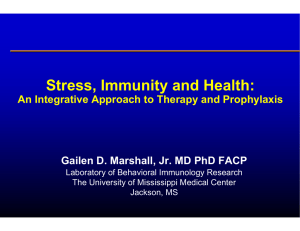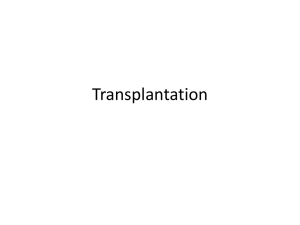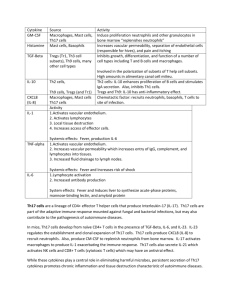Supplementary Data
advertisement
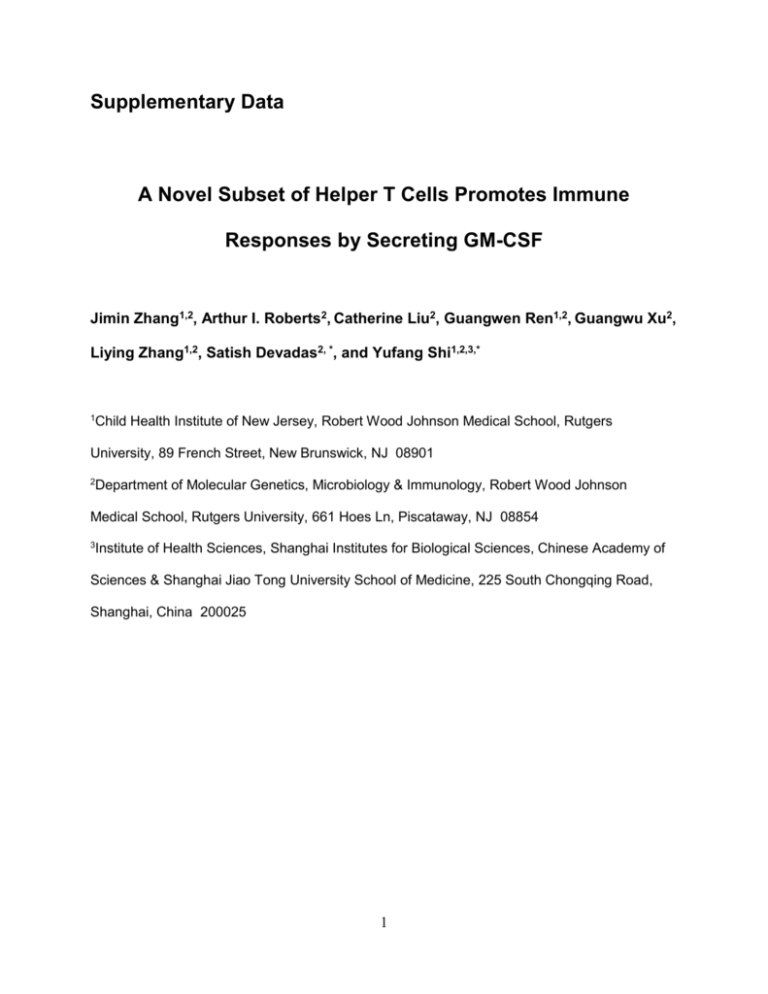
Supplementary Data A Novel Subset of Helper T Cells Promotes Immune Responses by Secreting GM-CSF Jimin Zhang1,2, Arthur I. Roberts2, Catherine Liu2, Guangwen Ren1,2, Guangwu Xu2, Liying Zhang1,2, Satish Devadas2, *, and Yufang Shi1,2,3,* 1 Child Health Institute of New Jersey, Robert Wood Johnson Medical School, Rutgers University, 89 French Street, New Brunswick, NJ 08901 2 Department of Molecular Genetics, Microbiology & Immunology, Robert Wood Johnson Medical School, Rutgers University, 661 Hoes Ln, Piscataway, NJ 08854 3 Institute of Health Sciences, Shanghai Institutes for Biological Sciences, Chinese Academy of Sciences & Shanghai Jiao Tong University School of Medicine, 225 South Chongqing Road, Shanghai, China 200025 1 Supplementary Methods Differentiation of Th17 and Treg cells Naïve CD4+ T cells were purified from splenocytes of BALB/c mice by negative selection using immunoaffinity columns (mouse T cell CD4+ subset isolation kit, R&D Systems, Minneapolis, MN) and differentiated into T helper subsets. To generate Th17 cells, purified CD4+ T cells were stimulated with plastic-bound anti-CD3 (coated at 1 μg/ml) and anti-CD28 (soluble, 2 μg/ml) and cultured in complete medium (RPMI 1640 medium supplemented with 2 mM Lglutamine, 50 M 2-mercaptoethanol, 10% heat-inactivated FBS, and 10 mM Gentamycin) supplemented with anti-IFN-γ (10 μg/ml), anti-IL-4 (10 μg/ml), IL-6 (20 ng/ml), and recombinant human TGF-β1 (5 ng/ml) for 3 days. To generate Treg cells, purified CD4+ T cells were differentiated under similar conditions except that the complete medium was supplemented with anti-IFN-γ (10 μg/ml), anti-IL-4 (10 μg/ml), and recombinant human TGF-β1 (10 ng/ml). 2 Supplementary Figure Legends Figure S1. Expression of Th1 transcription factor Tbet is diminished in ThGM cells. Th1, Th2, Th17 and ThGM cells were differentiated and harvested thereafter. Expression levels of the Th1 transcription factor Tbet in the cells were determined by quantitative PCR after normalized to -actin (defined as 10,000 arbitrary units). Results shown are representative of three independent experiments. Figure S2. Expression of Th2 transcription factor GATA-3 is diminished in ThGM cells. Th1, Th2, Th17 and ThGM cells were differentiated and harvested thereafter. Expression levels of the Th2 transcription factor GATA-3 in the cells were determined by quantitative PCR after normalized to -actin (defined as 10,000 arbitrary units). Results shown are representative of three independent experiments. Figure S3. Expression of Th17 transcription factor RORt is diminished in ThGM cells. Th1, Th2, Th17 and ThGM cells were differentiated and harvested thereafter. Expression levels of the Th17 transcription factor RORt in the cells were determined by quantitative PCR after normalized to -actin (defined as 10,000 arbitrary units). Results shown are representative of three independent experiments. Figure S4. Expression of Treg transcription factor FoxP3 is diminished in ThGM cells. Th1, Th2, Treg and ThGM cells were differentiated and harvested thereafter. Expression levels of the Treg transcription factor FoxP3 in the cells were determined by quantitative PCR after normalized to -actin (defined as 10,000 arbitrary units). Results shown are representative of three independent experiments. 3 Figure S5. ThGM cells do not secret IL-17 at a level comparable to Th17. Th1, Th2, Th17 and ThGM cells were differentiated and culture supernatants were collected after stimulation. The level of IL-17 in culture supernatants was determined by multiplexed bead array immunoassay using Luminex. *** p <0.001; ns, non-significant; bars represent means SEM of three independent experiments. Figure S6. ThGM cells express NFATc1, AP-1 and RUNX1. Th1, Th2, Treg and ThGM cells were differentiated and harvested thereafter. Expression levels of the transcription factors NFATc1, AP-1 and RUNX1 in the cells were determined by quantitative PCR after normalized to -actin (defined as 100,000 arbitrary units). Results shown are representative of three independent experiments. Figure S7. ThGM cells respond to stimulus strength in a dose dependent manner. ThGM cells were restimulated with different doses, from 0.05 g/ml to 10 g/ml, of anti-CD3. Apoptosis was assessed at 18h by hypodiploid DNA content after propidium iodide staining and analyzed by flow cytometry. Values represent percentages of hypodiploid cells (A). Comparison of ThGM AICD under different doses of anti-CD3 was further determined by statistical analysis. ** p <0.01, *** p <0.001; values represent means SEM of three independent experiments (B). Figure S8. AICD in ThGM cells are only partially inhibited by dexamethasone. ThGM cells were restimulated with the optimal dose of anti-CD3. Different doses of dexamethasone from 0.1 ng/ml to 10 ng/ml were added to the cultures. Apoptosis was assessed at 18h by hypodiploid DNA content after propidium iodide staining and analyzed by flow cytometry. Values represent percentages of hypodiploid cells. 4 Figure S9. Dexamethasone-inhibited AICD reveals different pattern between ThGM cells A1.1 T cell hybridoma. ThGM cells (A) or A1.1 T cells (B) were restimulated with anti-CD3 to initiate AICD. Different doses of dexamethasone from 0.1 ng/ml to 10 ng/ml were added to the cultures. Apoptosis was assessed at 18h by hypodiploid DNA content after propidium iodide staining and analyzed by flow cytometry. Values represent percentages of hypodiploid cells. Comparison was further determined by statistical analysis. ** p <0.01, *** p <0.001; values represent means SEM of three independent experiments. 5
